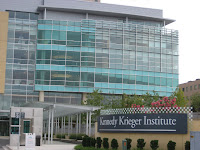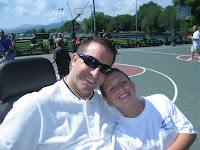
By: Janelle LoBello
Name:Danny Heumann
Injury: T4 paraplegic
Mechanism of injury: Auto accident
Date of injury: August 13, 1985
Hometown: Riverdale, NY
Website: heumannlycapable.com
Name: Alan Brown
Injury: C5, C6 quadriplegic
Mechanism of injury: Swimming accident
Date of injury: January 2, 1988
Hometown: New York, NY
Website: atbf.org
Having been classmates and friends since the 1980s, Danny Heumann and Alan T. Brown share a unique story that has now brought them together again as members of the Christopher & Dana Reeve Foundation Board of Directors.
Danny was paralyzed at 18-years-old in August 1985 in a car accident. In January 1988, Alan became paralyzed, at the age of 20, as a result of a swimming accident.
"We're two New York boys who bit the bullet," says Danny, 42, of himself and Alan, 43. "He broke his neck. It wasn't enough to be paralyzed; he had to become a quad to show me up!"
"I would never think in a class of 70 kids, that two kids, two best friends, were going to end up in wheelchairs," says Alan. "We walked down the aisle together at our high school graduation," explains Alan, who considers Danny to be like a brother to him. "That was probably the last time I saw Danny walking."
Danny's broken back
Just two weeks before he was set to begin his freshman year at Syracuse University, Danny was injured in an auto accident while serving as a camp counselor in the Adirondacks. "The driver of the car I was in was speeding around a curb," explains Danny, quick to point out there were no drugs or alcohol involved. "He was killed, the two others walked away without a scratch, and I broke my back and was paralyzed."
When Danny was injured, Alan decided he would do all he could do to help his friend. "I would take him places, drive him around," says Alan. "Stuff I never thought I would be doing, but I didn't mind. I would help him take his wheelchair apart, get dressed, urological things … anything to make life easier."
Alan's broken neck
Three years later, Alan was vacationing in Club Med. "I was on my way to the beach and the other two buses in the group were warned not to go into the water because of a storm," explains Alan of his injury. "I went in the water and was pulled under a wave. I hit the ocean floor and heard a snap. I was underwater a little more than three minutes before my friends pulled me out. I was in spinal shock and very alert. I remembered learning from Danny's accident and told them not to move me."
On his 21st birthday, Alan underwent surgery to have two metal plates and 11 screws inserted in his C5 and C6 vertebra. "I laughed a lot and never really got upset; when I was in the ICU I tried to make the best of it. I learned that if I held my breath the alarms would go off. The nurses would run in, I would say, ‘Talk to me! I'm bored!'"
Channeling Christopher
Both Danny and Alan were friends with Christopher Reeve. They have picked up his torch, continuing to advocate for people living with paralysis.
"He didn't get to finish," says Alan, who originally met Christopher at a New York Rangers hockey game not long after he was thrown from his horse in 1995, "so I'm going to finish for him. He had such little movement, but never stopped moving. He was a leader, never stopped, never gave up."
"When I think about Christopher, I think about the incredible advocate he was," says Danny. "And not just because he was so visible, but because of how bright he was. As an advocate he had brilliance and knowledge of what he was advocating, he wasn't just a movie star. Today, that's how I model myself as an advocate. It's important to not just be passionate, but really know an issue inside and out."
Making changes
In 1986, Danny, along with his family and friends, started the Daniel Heumann Fund for Spinal Cord Research to give hope when there was no hope to be found. In 2003, he founded the motivational speaking company, Heumannly Capable. He graduated from Syracuse University in 1991 and received his law degree from American University in 1998.
Alan is co-founder of the Alan T Brown Foundation to Cure Paralysis (ATBF), established in 1988. ATBF supports scientific and medical research but he is most proud of the Foundation's Peer Mentoring Program. Alan is also founder and owner of PrimeTime Public Relations & Marketing in Hollywood, Florida.
"He and I were put in chairs for a reason," says Danny. "I don't believe the man upstairs was satisfied with our lives on foot. He thought Alan and I had more potential from sitting in chairs with a broken neck and broken back."
"I have pictures of us from before, standing together," says Alan. "Now, we're sitting together and making a difference in the SCI world."
Neither Danny nor Alan take their injuries sitting down. "We're game changers," explains Danny. "We change the game. Instead of being victims just lying in bed, we are in people's faces. Nobody's going to remember us for the amount of money in our bank accounts or the fancy cars we drive. People are going to remember us for the betterment of humankind."
"We had the worst circumstances with the best outlook," adds Alan.
What about healthcare?
Both men recognize the value of quality of life in the present for someone living with paralysis. "As much as I would love to walk again," says Danny, "most important to me, is to be able to have sensation again from my chest down."
Alan and his foundation, ATBF, are dedicated to "partnering with researchers that are conducting studies targeting specific problems associated with prolonged confinement to a wheelchair and paralysis."
Alan aims to provide assistance and support within the ATBF Peer Mentoring Program. "My goal is to touch one person or one family every day," explains Alan. "That is the first line of attack. When someone is hurt, I want to be in the room with them, with the family. I had three phone calls yesterday from different families just thanking me. That's touching one life a day."
Danny is involved in the development of regenerative medicine industry. "I believe that in the next 10-15 years the way medicine is today will change radically," explains Danny. "The development of the regenerative medicine industry will help keep people healthier, cure diseases, and spinal cord injury. I want to leave a legacy to my daughter, not only for spinal cord injury, but all diseases."
In June 2007, Danny's Foundation joined the Reeve Foundation. As part of the merger, Danny established the Daniel Huemann Young Scientists Fund. He, who now resides in Michigan, also became a member of the Reeve Foundation's Board of Directors.
In October 2009, Alan, who now resides in Florida, was elected to the Reeve Foundation Board of Directors focusing on the duel mission of the Foundation, Care and Cure.
http://www.christopherreeve.org/site/c.mtKZKgMWKwG/b.5852265/k.822C/Two_Friends_Two_Injuries_One_Mission.htm






























